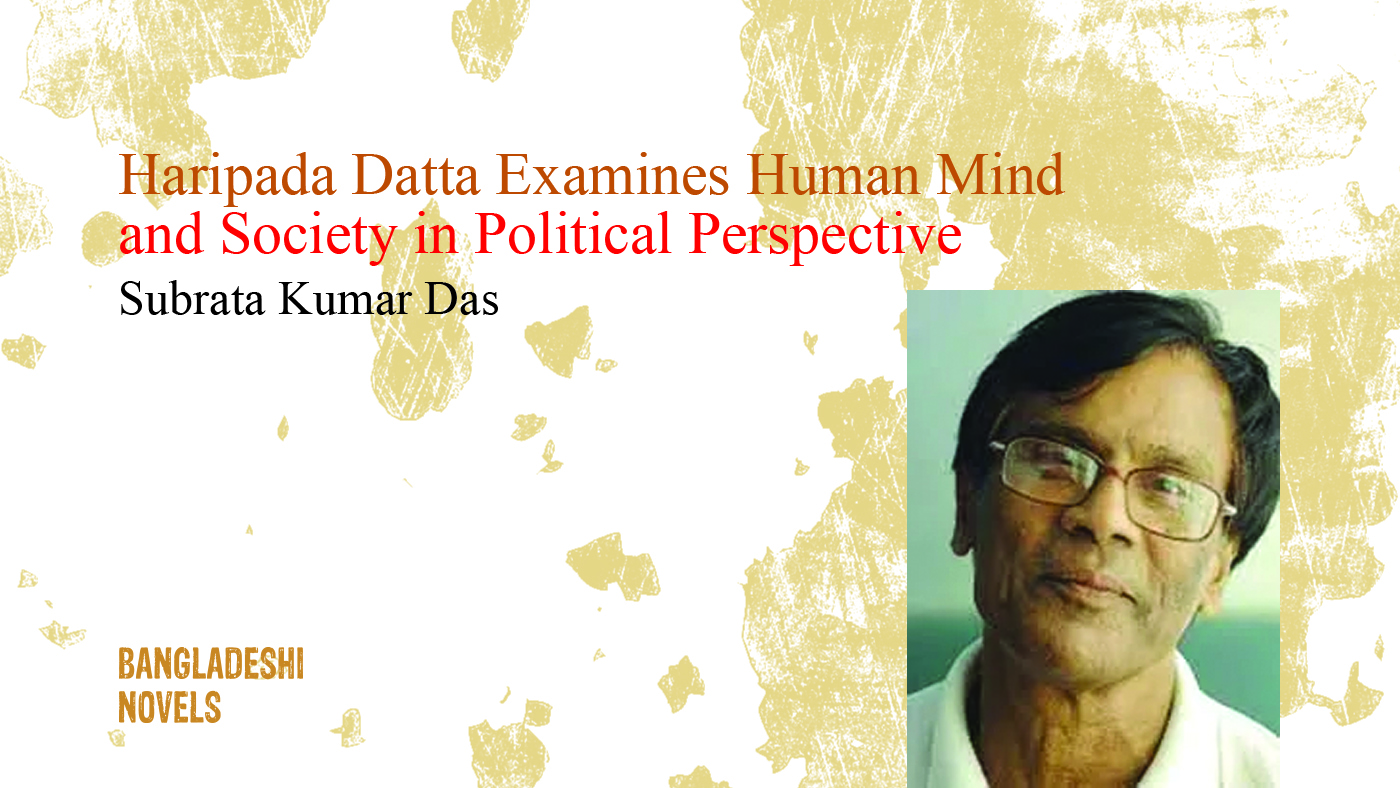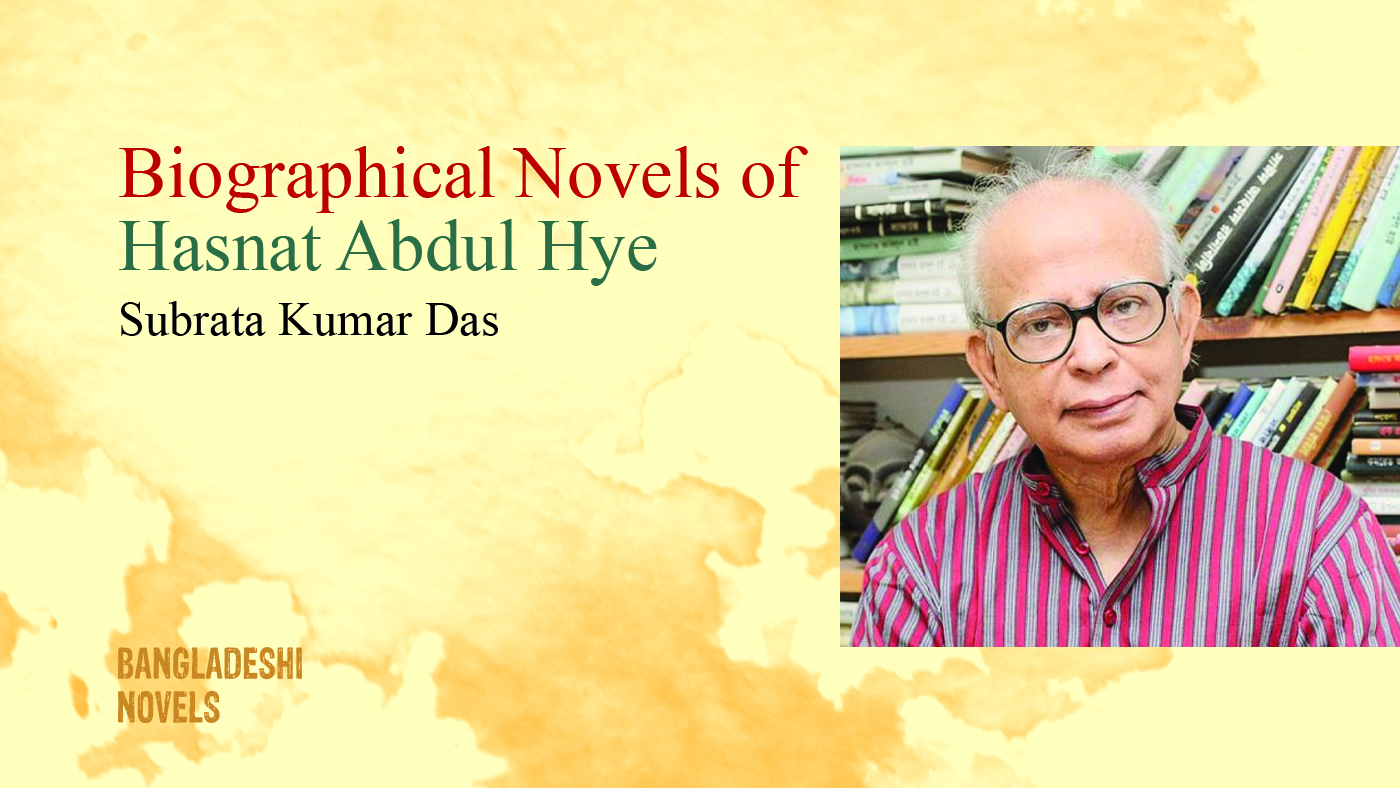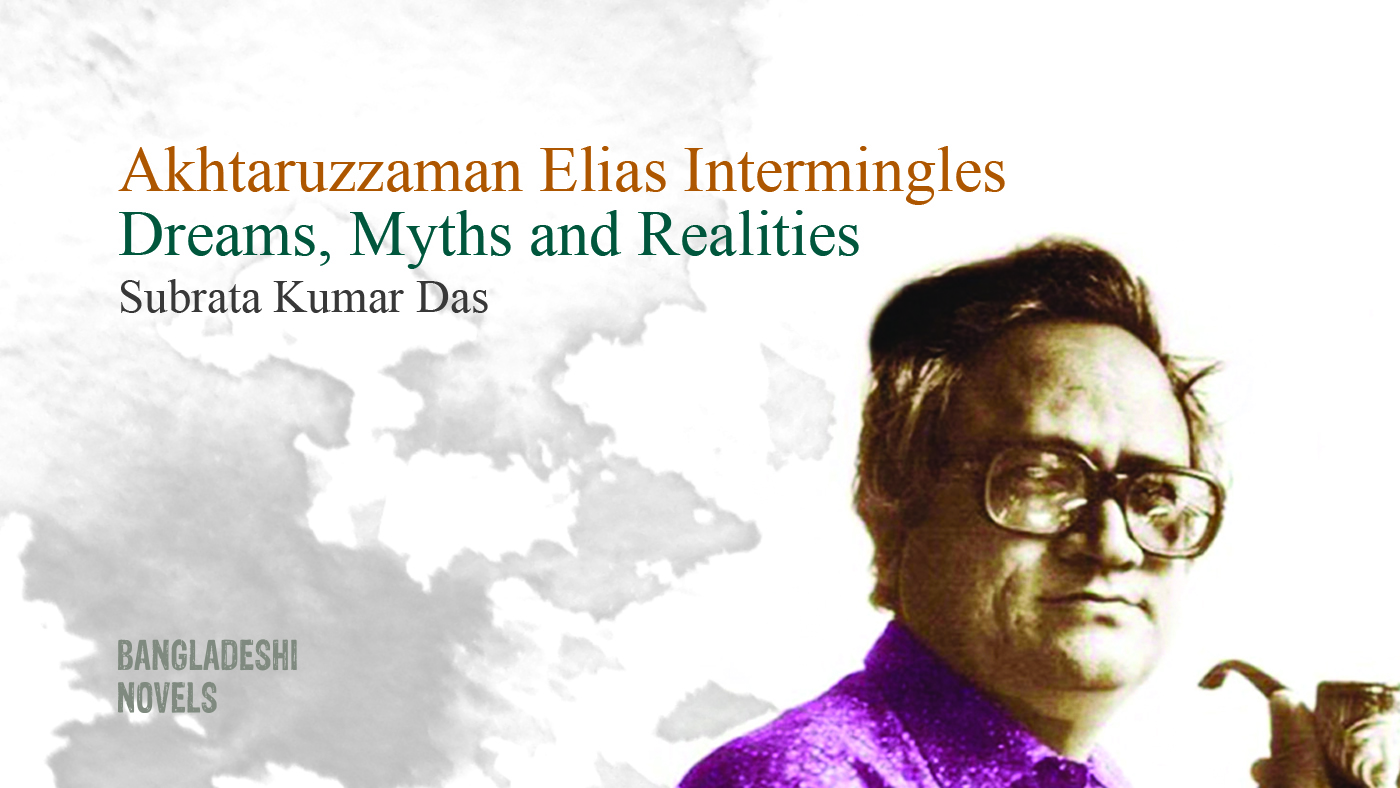
Nasreen Jahan (b 1964) has established herself as a major novelist in contemporary Bangla fiction. She first revealed her literary inventiveness through some memorable short stories in the middle of the eighties. Her entrance in the realm of novel was announced in 1993 with the publication of Urukku (The Restless) and fortunately her first novel brought her an important literary award. Subsequently she had published a good number of novels in the last decade. Her later books are Chandrer Prothom Kola (The First Phase of the Moon, 1994), Jakhan Charpasher Batigulo Nive Ashchhe (When All Lamps Dim 1995) Chandralekhar Jaadubistar (Magical Exposition of Chandralekha, 1995) Sonali Mukhosh (The Golden Mask 1996) Baidehi (The Incorporeal, 1997) Li (Titled after the last syllable of the name of heroine Sonali, 1997) Krus Kathe Konya (The Daughter on the Cross, 1998) Ure Jai Nishipakshi (The Nocturnal Bird Flies Away, 1999) etc.
The main feature in the novels of Nasreen Jahan is her use of magic realism. Before going to the heart of the magical elements in Nasreen Jahan’s novels, let us first discuss magic realism. About Gabriel Garcia Marquez (b 1927) whose One Hundred Years of Solitude ‘is regarded as a paradigm of magic realism’ Larousse Dictionary of Writers (ed. Rosemary Goring, New York, 1994) comments: ‘he is a master of magic realism, the practice of rendering possible events as if they were wonders and rendering impossible events as if they were common place. Spinning from one fantastic, hyperbolic happening along in a torrent of narrative’ (P.353). Though magic realism got established in the eighties it actually dates back to Jorge Luis Borges’s (1899-1988) fiction. His Historia Universal de la infamia is ‘regarded by many as the first work of magic realism’ (J A Cuddon, Dictionary of Literary Terms and Literary Theory, Penguin Books, UK, 1992, P.522). Another name worthy to be mentioned with Borges is Alejo Carpentier (1904-1980), a novelist of Cuba. Other writers who practiced magic realism with distinction are Italo Calvino (1923-1985), John Robert Fowles (b 1926), Gunter Wilheim Grass (b 1927), Milan Kundera (b 1929), Emma Christina Tennant (b 1937), Angela Olive Carter (1940-1992), Peter Carey (b 1943), Salman Rushdie (b 1947) and Graham Swift (b 1947).
In the popular handbook A Glossary of Literary Terms M H Abrams writes ‘the present day novels of magic realism achieve their effects in large part by exploiting a realistic manner in rendering events that are in themselves fantastic, absurd or impossible’. (6th edition, 1993, P.174). The Oxford Companion to English Literature deserves that “Magic realistic novels and stories have typically, a strong narrative drive, in which the recognizably realistic magic with the unexpected and the inexplicable, and in which elements of dream, fairy-story, or mythology combine with the everyday, often in a mosaic or Kaleidoscopic pattern of refraction and recurrence? (ed. Margaret Drabble, 3rd Impression, Great Britain, 1997, P. 616). J. A. Cuddon identifies the characteristic features of magic realism in a more elaborate and analytical way in his voluminous above mentioned book. Cuddon declares: ‘Some of the characteristic features of this kind of fiction are the mingling and juxtaposition of the realistic and the fantastic or bizarre, skilful time shifts, convoluted and even labyrinthine narratives and plots, miscellaneous use of dreams, myths and fairy stories, expressionistic and even surrealistic description, arcane erudition, the element of surprise or abrupt shock, the horrific and the inexplicable’ (P. 522). Cuddon, in fact, has more successfully identified all the major features of magic realism.
In Bangladesh we find magic realism mostly in the works of three novelists. They are Aktaruzzaman Elias (1943-1997), Shahidul Zahir (b 1953) and Nasreen Jahan. If we look at the chronological development of magic realism in our literature we will see that the first attempt in this arena is Shahidul Zahi’s Jiban O Rajnaitic Bastabata (Life and Political Reality, 1987). The next effort came from Nasreen Jahan. Her third novel Chandralekahar Jaadubistar is a milestone in this regard. In the same year Shahidul Zahir’s second novel She Rate Purnima Chhilo (That was a Moonlit Night) came out. The third novelist to have attempted successfully is this style is Akhtaruzzaman Elias. His second novel Khoabnama (Dream Epic, 1996) is another major attempt. In this context, it will not be irrelevant if we mention the name of Syed Waliullah (1922-1970). Among his three novels, the last two Chandrer Amabashya (Black Moon, 1964) and Kando Nodi Kando (Cry River Cry, 1968) have some features, which resemble magic realist novels.
Actually no works by any of the above three novelists portray all aspects of magic realism. Shahidul Zahir manipulates ‘skilful time shifts’ and ‘labyrinthine narratives and plots’ well but in Khoabnama these are absent. On the other hand, Aktaruzzaman Elias is most successful in ‘miscellaneous use of dreams, myths and fairy stories.’ However traits like ‘mingling and juxtaposition of the realistic and the fantastic or bizarre’ and ‘the element of surprise or abrupt shock’ can be observed in all the three novelists.
Nasreen Jahan’s first novel Urukku has Neena as the heroine. Neena is an outcome of an impotent and declining society. We get details of both the inner world and outer life of Neena. The impure outer world is exposed in the book in a trustworthy manner. Different phases of Neena’s inner mind are also demonstrated in the novel. All the descriptions of Urukku are outwardly very realistic. There Neena, the protagonist of the story, is sub-let with Shanu and her husband Kamal. Previously Neena was married to Rezaul, which was the result of a love affair. But their relation could not endure fairly Neena could know that Rezaul had sodomy-relation in his pre-marital life. The story of Urukku begins with Neena’s divorce. The other incidents that take place in the book later on are also described with full sympathy. When the novel ends we see Neena in a difficult situation since she is carrying a child from her romantic relation with Rezaul. Due to requests from her friends, Neena agrees to keep alive her child. She thus appears to be a rebellions female character.
In her second novel Chandrer Prothom Kola, Nasreen shifted to a different sort of narration where dream takes the upper hand. In this novel we get the story of Amrita and a young man along with the juxtapositional presence of the writer of the story. In the novel, the writer Nasreen Jahan displays her new technique of story telling utilizing allegory in fairy tale elements. In her first novel she had used the element of shock very often but the whole delineation of the story was not that of the magic realist. In Chandrer Prothom Kola, she experimented this style, though she had to wait till her third novel Chandralekhar Jaadubistar to be successful.
This novel opens with the following passage:
Her palace is a wooden one. The palace is submerged half in the current water of the river. She is a glamorous beauty. White beads of the rosary are on her person, her skin is a colour of mixed milk and blood. She does not appear as the queen of this country, but when the flashes of her white teeth blaze all around, rows of people are seen standing about her and her voice shivers in the speed of the air, her activities become apparent. Her source of power is her capability to hypnotize. Thus she flourished.
Her name is Chandralekha. It is said that she has been born of a river. That is a manifold legend. She was floating on a wooden deck. What a wonder with that wood – the roaring water couldn’t touch her breath. Everyone knows this story. Everyone knows that the water-carried woman Chandralekha is more than human. Looking at her forehead people from all religions can see the mark of their own religion shining brightly there.
She laughs in her sleep. The waters of the river rush to the hills. On the peak of the hill there lives a bat. In the dead of night the bat comes on the roof of Chandralekha.
The inhabitants residing far see on that roof of the palace on the river the fair woman with the bat on her fingertips. The scared village-folk bow to her. (Translation)
In the novel of sixty-eight pages only the writer in the very introductory page acquaints her readers with Chandralekha. In the direct method she narrates the story in a fairy-story style. This style is deployed through the whole novel.
Chandralekha is a queen of a remotest country. She was ravished at wartime. Through innumerable incidents she ascended the throne of this country. As a queen, her behaviourial intrigues pose as her only manners. Through the fairy-story approach, Nasrin presents the politico-social scenario of the country to us. No doubt Nasrin has been more adept in using the magic realist elements in Chandralehar Jaadubistar than Chandrer Prothom Kola. In language and presentation Chandralekhar Jaadubister is more meaningful. But we observe that she diverges from this method of narration and uses the narratology of Urukku in her next novels.
In Jakhan Charpasher Batigulo Nibhe Aashche Nasreen utilizes the style that she used in Urukku, though thematically there is no resemblance between the two novels. In this novel Saraju is the protagonist. We notice that Saraju’s world is darker than that of Nakib’s. During the liberation war, all the members of Saraju’s family converted to Islam to save themselves. At that time Saraju was attracted by the calmness of a Pakistani soldier. When the whole village was attacked by the Pakistani army, Saraju was raped before her father.? Saraju is always tormented by that past incident. After the liberation war the father-daughter relation becomes impossible. Then comes the widower friend of Saraju’s father Shafiul Aalam. Considering every thing, he marries Saraju. Before the marriage ceremony she is converted to Islam. In one stage the husband also grows inactive remembering her past incidents. In such a time her husband’s son Rahul comes back from abroad. Saraju becomes a friend to Rahul. Suddenly dies her husband, and consequently the other members of the family expel her out of the house. Saraju remains alone. Gives birth a child. Falls in the grip of Humayn Reza, her dead husband’s friend. Both economically and mentally Sauaju becomes crippled. Such deliberation of true realities is also available in her next novel Sonali Mukhosh.
In this novel we notice two parallel story lines – one of Nishi who is trapped in the family of her husband Afzal, and the other is about Zahid, the pre-marital lover of Nishi. The present as well as the past is intermingled in the novel very skillfully. The love affair of Nishi and Zahid is described vividly. For some social and familial context the love affair can not result in marriage. Later on, she becomes close to Shajidul who stays with Mamata, a well wisher of them. Showing a false excuse of secret marriage they live together as a married couple. After about two years Shajidul gets sentence for some other corruption. Within less than a year Nishi decides to marry Afzal, an acquaintance of seven days only. After about seven years of that marriage the story of Sonali Mukhosh begins. Gradually the novel reveals every detail of the previous incidents of the lives of Nishi and Zahid. In the novel the other worthwhile characters are Nishi’s husband Afzal, Nishi-Aafzal’s friends Reza-Swati, Nishi’s sister Rini, and Osman whom Sajidul met in the jail and followed to come out of the jail.
The older generation is also presented in the novel carefully. The most significant among them are Zahid’s parents. Other pairs are Aafzal’s and Nishi’s parents. They emerge from both rural and urban societies, and through them the authoress established the different attitudes from parents to children and vice versa.
After the detailed depiction of the impatience and frivolity of conjugal life in Sonali Mukhosh, Nasreen writes Kruskathe Kanya. This is also a story of middle-class city life where pain and agony are always present. Through the story of Nilufar and her environs and association Nasreen portrays events resembling the stories of Urukku and Sonali Mukhosh.
In the year 1999 Nasreen published Ure Jai Nishipakshi. That is also very striking bcause of its use of magic realism. But the allegorical and dream-like fairy elements are not as evident in Ure Jai Nishipakshi as they were in Chardralekhar Jaadubistar. Ure Jai Nishipakshi begins in the following way:
In the dead night the unknown birds cry in the bamboo-jungle, ‘who’s there, who’s there’? The old woman replies, ‘I’m here, I’m here’.
The old woman tries to remove the darkness around lighting her hand-made lamp in response to an unheard call. The more the night stretches, the more the outer world calls her. That wind consists of rushing sound of waves as its breath. The old woman seems beaten by insects in her bed.
With the rush of the dust, the old woman loses her senses.
In her clay-made house high tide wants to rush breaking the doors. The high tide of the haor does not fear the earth or the sky. The mountainous Banyan tree also shrieks. With the speed of the air, the cold blood flowing under the wrinkled skin of the aged woman receives new heat. She attains the infatuation of an insect that wants to kills itself jumping into fire. Her head gets obsessed. The poor lice under her rough hair burn in that fire. The old woman gets so mad, particularly in the moonlit nights, that she cannot hold herself stand straight. While she tries to come out under her ragged quilt, it seems that she has fallen in the unfathomable water. From that ice-cold water when she tries to come out she again hears that undying call, ‘who’s there, who’s there’ ?
The old woman cries out ‘I’m here, I’m here’ in such a voice that her throat has been choked up with water (Translation).
Through this description of Ure Jai Nishipakshi we get three old women full of unreality. Approaching through this supernatural episode in the next chapter we get Osman, a product of true reality but not bereft of unreality totally. Gradually we realize that thirty years back Osman left this village when enemies killed his parents. We can also realize his re-appearance in that village after thirty years is impossible to be real in a true sense. Osman gets shelter after the boat wreck in the home of the influential Mannaf Khan of Nayanpur who killed Osman’s parents with his associates and grasped all their wealth. After his entrance in that village the people there appear to Osman in a two-fold way – one from his memory, another from his present reality. Moreover, there are the legendary stories of the power of the three old women, the elder of whom saved Osman at his birth with her miraculous power; the episode of Chandrani; and the episode of Fazlu-Raisuddin, mates from Osman’s boyhood. Along with them there is the story of the lake of bell metal, the story of the shore of birds. We can not but agree that while both Chandralekhar Jaadubistar and Ure Jai Nishipakshi are journeys through unreal worlds but Ure Jai Nishipakshi does not expose the inner truths as effectively in Chandralekhar Jaadubistar.
It we examine all the novels of Nasreen Jahan we will observe that most of her novels are full of dreams, fairy tale and mythical elements.
‘Element of surprise or abrupt shock, the horrific and the inexplicable and arcane erudition’ are also very evident in most of her novels. Ure Jai Nishipakshi and Sonali Mukhosh can be cited as prominent in this regard. We also notice the ‘mingling and juxtaposition of the realistic and the fantastic or bizarre’ in the above two novels along with Chandrer Prothom Kalaa and Chandralekhar Jaadubistar. But we must agree that only in the last two novels of Nasreen we meet the quality that is called ‘convoluted and even labyrinthine narration and plot’ among which Chandrer Prothom Kola is an experiment and Chandralekhar Jaadubistar is a success.







